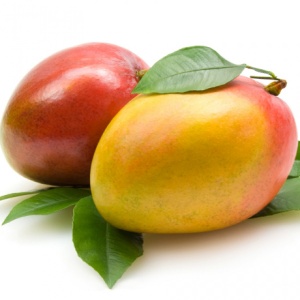Mango
Other Names : Mangifera Indica.
Mango is one of the delicious seasonal fruits grow in the tropics. The tree is believed to be originating in the sub-Himalayan plains of Indian subcontinent. Botanically, this exotic fruit belongs within the family of Anacardiaceae, a family that also includes numerous species of tropical-fruiting trees in the flowering plants such as cashew, pistachio,...etc. Mango is a tropical tree cultivated in many regions of India and now distributed wide across the world in many continents. Usually, fruits grow at the end of a long, string like stem, with sometimes more than one fruit to a stem.
See also : Mango leaves
Special Precautions of Mango
High fructose content.
The benefits of Mango are
The mango fruit contains vitamins A, C and D along with beta-carotene. In Unani medicine, mangos are used to remove toxins, treat anemia, and heal the nervous system. Ayurvedic medicine uses the dried mango flowers to treat diarrhea, dysentery, as well as urinary tract infections (UTI). Mango leaves, seeds, roots, bark, as well as the fruit all contain healthy nutrients, especially the phenolic acids, flavonoids like catechin, and the xanthone mangiferin. Mango has a high ORAC score because of the presence of natural antioxidants found in the fruit. While the high iron count in mangos treats anemia, mango pulp is added to facial products because of its ability to prevent acne by cleaning pores.
- Prevents Cancer: Research has shown antioxidant compounds in mango fruit have been found to protect against colon, breast, leukemia and prostate cancers. These compounds include quercetin, isoquercitrin, astragalin, fisetin, gallic acid and methylgallat, as well as the abundant enzymes. There is some evidence that mangiferin also acts to prevent tumor growths in some cancers.
- Lowers Cholesterol: The high levels of fiber, pectin and vitamin C help to lower serum cholesterol levels, specifically Low-Density Lipoprotein (the bad stuff)
- Heart : Research has shown that mangiferin can improve heart. This nutrient from the mango tree can lower blood sugar and lipid levels. According to the Institute of Medicine, women should have 25 g of fiber daily, at a minimum. One cup of mango as more than 2.5 g of dietary fiber, and eating it along with other fiber-rich foods contribute toward meeting that goal. As with all high fiber diets, heart disease risks are lessened.
- Clears the Skin: Can be used both internally and externally for the skin. Mangos clear clogged pores and eliminate pimples.
- Eye Health: One cup of sliced mangoes supplies 25 percent of the needed daily value of vitamin A, which promotes good eyesight and prevents night blindness and dry eyes.
- Alkalizes the Whole Body: The tartaric acid, malic acid, and a trace of citric acid found in the fruit help to maintain the alkali reserve of the body.
- Brain Health. Improve mood and overall brain ability with mangos. They have large amounts of the vitamin B-6 as well as glutamine acid which helps to improve neurotransmitter function, so the brain remains healthy while also benefiting from improved memory and concentration.
- an excellent source of Vitamin-A and flavonoids like beta-carotene, alpha-carotene, and beta-cryptoxanthin. 100 g of fresh fruit provides 765 mg or 25% of recommended daily levels of vitamin A. Together; these compounds are known to have antioxidant properties and are essential for vision. Vitamin A is also required for maintaining healthy mucus membranes and skin. Consumption of natural fruits rich in carotenes is known to protect the body from lung and oral cavity cancers.
- a good source of potassium. 100 g fruit provides 156 mg of potassium while just 2 mg of sodium. Potassium is an important component of cell and body fluids that helps controlling heart rate and blood pressure.
- a very good source of vitamin-B6 (pyridoxine), vitamin-C and vitamin-E. Consumption of foods rich in vitamin C helps the body develop resistance against infectious agents and scavenge harmful oxygen-free radicals. Vitamin B-6 or pyridoxine is required for GABA hormone production within the brain. It also controls homocystiene levels within the blood, which may otherwise be harmful to blood vessels resulting in CAD and stroke.
- It composes moderate amounts of copper. Copper is a co-factor for many vital enzymes, including cytochrome c-oxidase and superoxide dismutase (other minerals function as co-factors for this enzyme are manganese and zinc). Copper is also required for the production of red blood cells.
- Mango peel is also rich in phytonutrients, such as the pigment antioxidants like carotenoids and polyphenols.
